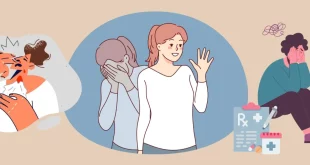Conquer Your Fears: A Step-by-Step Guide to Overcoming Phobias. Phobias are intense, irrational fears of specific objects, situations, or activities. Common examples include fear of heights (acrophobia), fear of flying (aviophobia), and fear of spiders (arachnophobia). These fears can significantly interfere with daily life, causing individuals to avoid certain situations and experiences.
Understanding and addressing phobias is crucial for improving quality of life. Historically, phobias have been recognized and treated in various ways, from early psychological theories to modern therapeutic approaches. The benefits of overcoming phobias are substantial, including increased confidence, greater freedom in daily activities, and overall mental well-being.
Transitioning to effective strategies and methods for managing and ultimately overcoming phobias is essential for those seeking relief from these debilitating fears.
Diagnose “How to Get Over Phobias”
Diagnosis is a critical step in understanding and addressing phobias. Proper identification of the specific fear and its triggers can significantly inform the treatment process.
Tip 1: Identify the phobia through detailed self-assessment or professional evaluation. Recognize specific situations or objects that trigger intense fear.
Tip 2: Monitor and document the frequency and intensity of phobic reactions. Keeping a diary can provide valuable insights into patterns and triggers.
Tip 3: Consult a mental health professional for a thorough assessment. A psychologist or psychiatrist can help determine the nature and extent of the phobia.
Tip 4: Use standardized diagnostic tools and questionnaires. Instruments like the DSM-5 criteria can aid in accurate diagnosis.
Tip 5: Rule out medical conditions that might mimic phobic symptoms. Comprehensive medical evaluation ensures that physical health issues are not contributing to the fear response.
Tip 6: Explore underlying psychological factors. Childhood experiences, trauma, or other mental health conditions can influence the development of phobias.
Tip 7: Evaluate the impact on daily life. Understanding how the phobia affects work, relationships, and personal well-being is essential for treatment planning.
Therapy Step by Step “How to Get Over Phobias”
Therapy for phobias involves structured and evidence-based approaches designed to reduce fear and improve coping mechanisms.
Step 1: Cognitive Behavioral Therapy (CBT). This involves identifying and challenging irrational thoughts related to the phobia, replacing them with more realistic perspectives.
Step 2: Exposure Therapy. Gradual and controlled exposure to the phobic stimulus helps desensitize the individual and reduce fear responses over time.
Step 3: Relaxation Techniques. Methods such as deep breathing, progressive muscle relaxation, and mindfulness can help manage anxiety symptoms.
Step 4: Medication. In some cases, antidepressants or anti-anxiety medications may be prescribed to help manage severe symptoms.
Step 5: Support Groups. Joining a group of individuals with similar phobias can provide emotional support and shared coping strategies.
Step 6: Virtual Reality Therapy. Using VR technology to simulate phobic scenarios can provide a safe and controlled environment for exposure therapy.
Step 7: Psychoeducation. Learning about the nature of phobias and the body’s response to fear can empower individuals and reduce feelings of helplessness.
Step 8: Lifestyle Changes. Regular exercise, healthy diet, and adequate sleep can enhance overall mental health and resilience.
Step 9: Ongoing Assessment and Adjustment. Regularly reviewing progress and adjusting the therapeutic approach as needed ensures continued improvement.
The primary benefit of therapy is the significant reduction in fear and anxiety, leading to improved daily functioning and overall quality of life.
Tips for “How to Get Over Phobias”
Implementing practical tips can facilitate the process of overcoming phobias, complementing professional treatment.
Tip 1: Educate yourself about the phobia. Understanding the fear can reduce its power and demystify irrational thoughts.
Tip 2: Practice mindfulness and meditation. These techniques help stay present and manage anxiety effectively.
Tip 3: Gradually face the fear in small steps. Start with less intimidating aspects and slowly work up to more challenging situations.
Tip 4: Use positive visualization. Imagine successfully facing the fear and feeling calm and in control.
Tip 5: Develop a strong support network. Friends and family can provide encouragement and reassurance.
Tip 6: Set realistic goals. Progress may be slow, so it’s important to celebrate small victories along the way.
Tip 7: Maintain a healthy lifestyle. Good physical health supports mental resilience.
These tips enhance coping mechanisms and contribute to gradual and sustained progress in overcoming phobias.
Transitioning from understanding to actively addressing phobias can significantly improve one’s quality of life.
FAQs about “How to Get Over Phobias”
Q1: What are common types of phobias? A1: Common types include acrophobia (fear of heights), aviophobia (fear of flying), and arachnophobia (fear of spiders).
Q2: How can phobias impact daily life? A2: Phobias can cause avoidance behavior, limiting personal, social, and professional activities.
Q3: What are effective treatments for phobias? A3: Cognitive Behavioral Therapy (CBT) and Exposure Therapy are highly effective in treating phobias.
Q4: Can medication help with phobias? A4: Yes, medications such as antidepressants or anti-anxiety drugs can help manage severe symptoms.
Q5: Is it possible to completely overcome a phobia? A5: Many individuals can significantly reduce or even overcome their phobias with proper treatment.
Q6: How long does treatment usually take? A6: Treatment duration varies, but many people see improvement within a few months of consistent therapy.
Q7: Are self-help strategies effective? A7: Yes, self-help strategies such as relaxation techniques and gradual exposure can complement professional treatment.
Conclusion: Understanding, diagnosing, and treating phobias is essential for those affected. Phobias, while often debilitating, can be effectively managed and overcome through a combination of professional therapy, practical tips, and supportive strategies. By addressing phobias proactively, individuals can significantly enhance their quality of life, gaining freedom from irrational fears and leading more fulfilling lives.
 Workplace Hero
Workplace Hero
